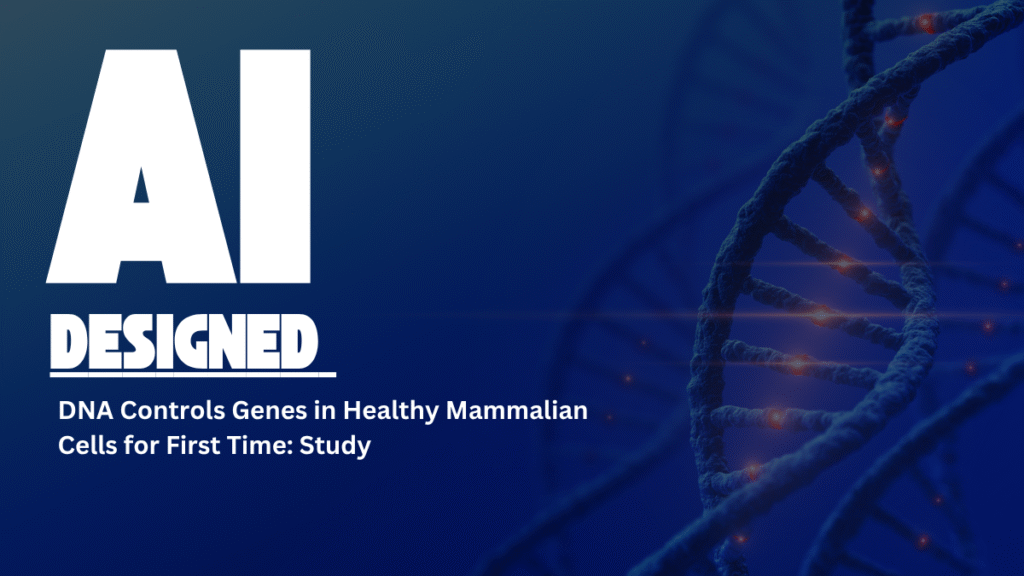In a groundbreaking leap for synthetic biology and genetic engineering, scientists have successfully used AI-designed DNA sequences to control gene expression in healthy mammalian cells for the first time. The study, published in a leading biotechnology journal, marks a pivotal advancement in how artificial intelligence and biology can work hand in hand to revolutionize medicine, agriculture, and our understanding of life itself.
This remarkable feat demonstrates how computationally generated DNA, crafted not by nature but by algorithms, can function as biological software to turn genes on or off with unprecedented precision. The implications are vast, ranging from safer gene therapies to programmable bio-machines that could one day treat diseases at the molecular level.

🧬 What Is AI-Designed DNA?
Artificial Intelligence (AI)-designed DNA refers to nucleotide sequences that are not naturally occurring but are generated by deep learning algorithms trained on vast genetic datasets. These algorithms predict which DNA configurations are most likely to perform a desired function, such as regulating gene activity or producing proteins.
Unlike traditional genetic engineering approaches, which rely on modifying natural genes or using trial-and-error experimentation, AI-designed DNA can be created with targeted functionality. This allows researchers to program biological responses, much like writing code for software applications.
🧪 The Breakthrough: Gene Control in Mammalian Cells
The recent study, conducted by a team of researchers from institutions in the US and Europe, marks the first time that synthetic, AI-generated DNA has been used to control gene expression in healthy mammalian cells, including human cell lines.
Using a deep learning model trained on tens of thousands of known gene promoters (genetic “switches” that turn genes on or off), the AI created entirely new sequences that had never existed before in nature. These sequences were inserted into mammalian cells, and astonishingly, they successfully activated and regulated gene expression with high specificity and stability.
Researchers tested their AI-designed DNA in various types of cells, including human embryonic kidney (HEK) cells and mouse immune cells. The AI-derived sequences not only performed as expected but in some cases, outperformed naturally occurring promoters in their ability to control gene activity.
🌐 Why This Matters: The Promise of Synthetic Biology
This breakthrough represents a paradigm shift in genetic engineering. Until now, most gene therapies and biotechnology applications have depended on modifying existing genetic material — an approach limited by evolutionary constraints.
AI-designed DNA, however, breaks free from nature’s templates, enabling:
- Fully customizable gene control for specific therapeutic outcomes.
- Scalable and cost-effective DNA design for research and industrial applications.
- A new generation of precision medicine tailored to an individual’s genetic profile.
🔍 Applications on the Horizon
This development opens the door to a range of transformative applications:
- Gene Therapy:
AI-designed DNA can offer safer and more precise ways to activate therapeutic genes in patients with genetic disorders, reducing off-target effects common with traditional gene editing techniques like CRISPR. - Cancer Treatment:
Programmable DNA elements could selectively activate genes that suppress tumor growth or enhance immune response, providing a new weapon against aggressive cancers. - Cell-Based Therapies:
Immune cells or stem cells engineered with AI-generated regulatory sequences could perform specific functions, like targeting pathogens or repairing damaged tissues. - Industrial Biotechnology:
AI-designed DNA could optimize the expression of proteins or enzymes in the production of biopharmaceuticals, biofuels, or sustainable materials, increasing yields and reducing costs. - Agriculture:
Synthetic gene promoters might be used to engineer crops with better resistance to drought, pests, or disease, or to enhance nutritional content.
🧠 The Role of AI in DNA Design
So, how exactly does AI design DNA?
The process starts with training deep learning models — often convolutional neural networks (CNNs) or generative adversarial networks (GANs) — on large datasets of natural promoter sequences and their gene expression profiles.
These models learn the “grammar” of gene regulation, identifying which nucleotide motifs (like TATA boxes or enhancers) influence gene activation and how they interact with transcription factors in cells.
Once trained, the AI can generate novel sequences optimized for desired outcomes, such as strong activation, tight regulation, or specific cell-type targeting.
This kind of predictive DNA engineering is not only faster than traditional methods but also more efficient. Researchers can simulate thousands of possibilities in silico before even entering the lab.
⚖️ Ethical and Safety Considerations
With great power comes great responsibility. The ability to create synthetic DNA that can manipulate gene expression in mammals raises important ethical and safety concerns.
Will AI-designed DNA behave predictably across different individuals and populations? Could this technology be misused for non-therapeutic enhancements or biohacking?
To address these risks, scientists emphasize the importance of rigorous testing, transparent protocols, and regulatory oversight. AI may design the DNA, but human bioethicists, clinicians, and policymakers must determine how it is applied.
🔬 How This Differs from CRISPR
CRISPR-Cas9 is a powerful gene-editing tool, but it works by cutting existing DNA and inserting or deleting sequences. In contrast, AI-designed DNA focuses on creating entirely new, functional elements to influence genes without altering the genome’s core structure.
This makes it potentially safer and more adaptable for therapeutic use, especially when editing is too risky or irreversible.
🌍 A Glimpse into the Future
This study signifies not just a technical milestone, but a philosophical one. For the first time, humans have created DNA sequences from scratch — using artificial intelligence — that can operate within the cellular machinery of mammals.
It’s a testament to how biology is becoming increasingly programmable. In the not-so-distant future, cells may be treated like software, with AI helping us write and debug the code of life.
The successful use of AI-designed DNA to control gene expression in healthy mammalian cells is a historic achievement that ushers in a new era for synthetic biology and genetic engineering. This innovation holds promise for medicine, agriculture, biotechnology, and more.
As artificial intelligence continues to evolve, so too will our ability to design and deploy biological systems with surgical precision, moving closer to a world where programmable DNA transforms how we treat disease, grow food, and understand what it means to be alive.



